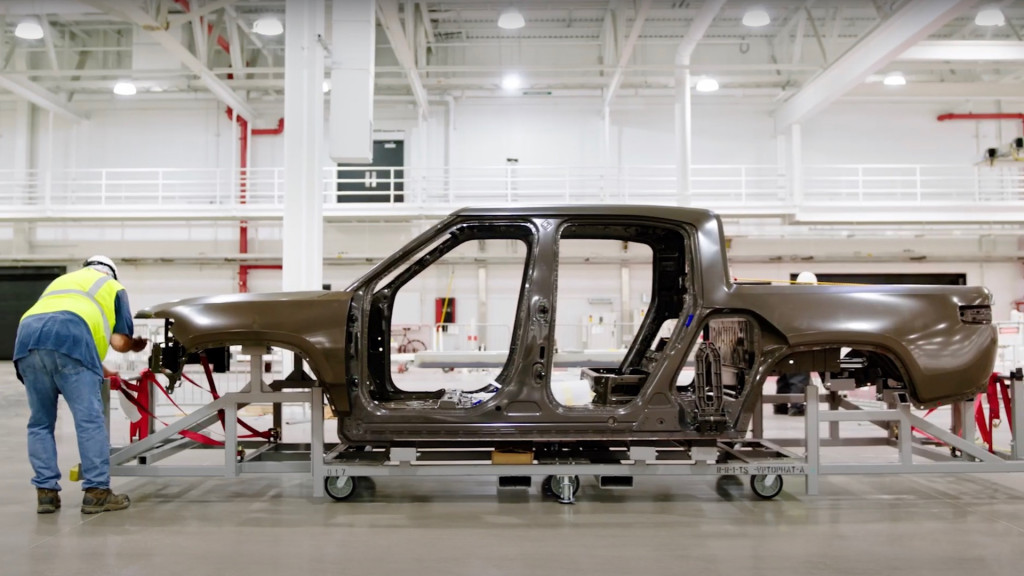Rivian on Tuesday confirmed that it will be delivering Max Pack versions of its R1S, in Dual Motor form, starting this fall.
According to Rivian, the R1S Max Pack will accelerate to 60 mph in as little as 3.5 seconds and offer three rows of seating.
With the announcement, part of a quarterly financial update for shareholders released Tuesday, the company said that it will soon provide an update on how those with a preorder can update it to the Max Pack version.
Rivian Enduro drive unit
Max Pack models will include a pair of Rivian’s Enduro single motor drive units, which were engineered by the company and produced in-house. Rivian earlier this month started producing saleable units of the unit, which is also used for front-wheel-drive commercial vans.
The company has said that it will use lithium iron phosphate (LFP) cells in its R1T and R1S versions with the Standard Pack, achieving an estimated range of 270 miles for the R1T and 260 miles for the R1S—plus new, higher range figures of 340 miles and 350 miles for the R1S and R1T, respectively, with the Large Pack and dual-motor layout. Note that these figures aren’t yet EPA-confirmed.

Rivian R1S and R1T updated specs and ranges – Feb. 28, 2023
Rivian EDV vans with the Enduro drive units are also shifting to LFP packs. The source of the LFP cells in all these trucks hasn’t yet been disclosed; they’re from a battery partnership that hasn’t yet been announced according to CEO RJ Scaringe.
Meanwhile, on an accompanying update call, Scaringe emphasized that ramping up production, cutting costs, and looking ahead to its mass-market R2 models set for 2026 are among the top priorities.
Scaringe said that the production ramp of the R1 lineup has equipped the team with manufacturing and product development experience that’s being applied to its first mass-market vehicle, the R2—and to the $5 billion Georgia plant that will build the R2 lineup.
“We have members across the organization from design to engineering and manufacturing, coming together to develop what we believe is a true category defining platform.”
“Over the next six months, we’ll be finalizing the majority of the core engineering and sourcing decisions that will drive how the R2 product line is built, and the speed at which we can ramp production to profitability,” he said.

Rivian R1T, R1S chassis
Rivian R2 lineup: Simplified for assembly, sourcing
Scaringe said that the R2 platform will have a lower cost structure and will leverage a lot of the tech it will be introducing into R1, including the Enduro drive units and an updated electronics architecture and network architecture, consolidating compute tasks to a small number of ECUs.
But it goes beyond that, he explained. By using larger stampings, and extrusions or stampings, there are fewer parts, joints, and components that need to be attached, and that simplifies assembly and the sourcing process.
As part of its quarterly update, Rivian anticipated that supply chain issues will persist well into 2023, and it estimated its vehicle production at 50,000 for the year—a figure that’s just over twice its 24,337 vehicles produced in 2022 but below the 60,000 that had been widely anticipated. Rivian noted that it exceeded 10,000 vehicles made in the fourth quarter of 2022.

Rivian R1T pre-production
The company now has 65,000 annual units of R1 capacity at Normal, but it’s planning to halt production and “re-rate” the plant next year, adding capacity for 85,000 units to reach its intended 150,000 production rate. The Georgia plant, Rivian has said, will have the capacity to make 400,000 vehicles once fully ramped up—so it’s conceivable that if Rivian has found profitability, it might be making 10 times the number of vehicles just a few years from now.
Because of that slow progress, however, Rivian reports that it is still making most of its deliveries based on pricing before March 1, 2022—when the company raised prices significantly, even for those who had made early preorders, only to restore previous pricing for existing preorders two days later after much backlash.
